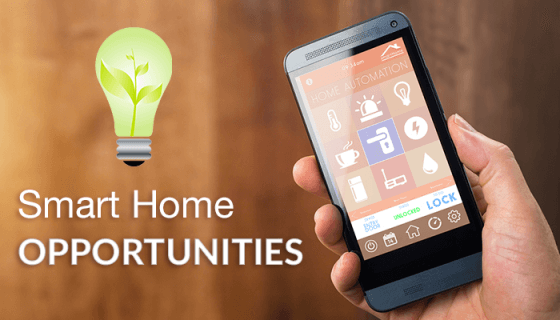Today’s smartest smart homes have your appliances talking to you through texts sent directly to your smartphone. We have thermostats that automatically adjust based not just on the temperature, but on your daily routine. Some smart homes allow the homeowner to control everything—from starting your coffee in the morning to locking your doors and arming your security system—right from your smartphone.
To the average homeowner, this might sound a little like George Jetson’s Skypad Apartment. But before you decide that smart homes are too far in the future to worry about, or are only available to the fantastically rich and famous (I’m looking at you Bill Gates), look at what’s happening in middle class homes right now. The reality is that smart homes are already starting to be built in large numbers. And the technology is well on its way to becoming more refined, more affordable, and more mainstream.
As a business person, that means that your customers are beginning to adopt the technology—and many expect that soon they’ll be able to convert their humble abode into a fully integrated smart home.
Convenience and coolness aren’t the only factors driving people to use new technology. Saving time and money can also be big incentives. One attraction of smart home devices is that they allow customers to bypass traditional technicians and repair personnel, and their high costs.
Think about it this way: If you can purchase and install an off-the-shelf security system that will text you and call the police or fire department when there is a problem, giants like ADT become obsolete. To compete, those companies are going to have to start selling DIY options. In fact, rumors are circulating that ADT is on the verge of offering a security monitoring system that consumers can install themselves. Simpler standalone home monitoring devices have been available for a few years from companies like Nest and Quirky. When the smart home security transformation happens, traditional home service providers will be hit hard if they can’t adapt.
Soon it will be commonplace for your appliances—including major appliances like air conditioners and refrigerators—to let you know when they need maintenance or even when a specific part isn’t working properly.
Reducing energy bills is one of the biggest reasons consumers choose to convert their homes to smart homes. And doing so is becoming increasingly easy because smart devices don’t require any complicated renovations involving changing electrical wires or upgrading the infrastructure. Consumers can choose from the 1.9 billion devices already on the market, including smart door locks, appliances and electronics, outlets, and lights bulbs, and can complete many of the upgrades themselves. There’s no need to call in an electrician or other contractor to do massive home overhaul.
Even with easy instillation, many people will prefer to outsource that function. So there will be huge opportunity for businesses who can offer smart home technology as a service—installing, monitoring, and maintaining it. There will be other opportunities for construction companies that can integrate smart devices into new builds and home renovations.
The bottom line is, if you provide home services, the rise of the smart home could hurt your business—unless you are willing to adapt to advancing technology and changing consumer mindsets.
According to new market research, smart home service providers are already beginning to gain traction in the marketplace. Smart homes are a Hard Trend that represents real opportunity for anyone in the industry. With foresight, you can figure out how to get ahead of your competitors and capitalize on the trend.
®2015 Burrus Research, Inc. All Rights Reserved.







Comments